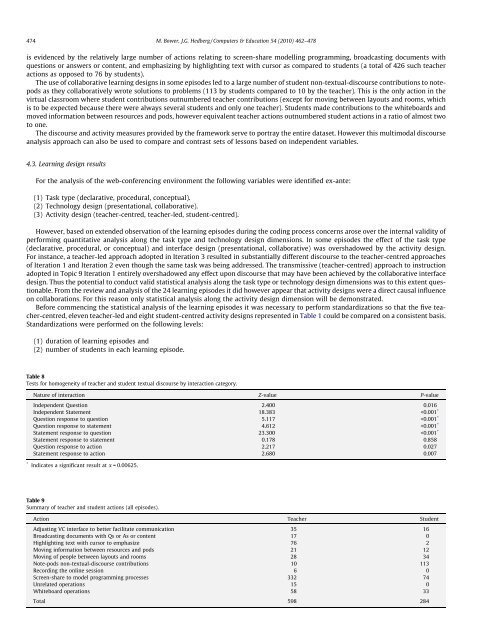A quantitative multimodal discourse analysis of ... - Anitacrawley.net
A quantitative multimodal discourse analysis of ... - Anitacrawley.net
A quantitative multimodal discourse analysis of ... - Anitacrawley.net
You also want an ePaper? Increase the reach of your titles
YUMPU automatically turns print PDFs into web optimized ePapers that Google loves.
474 M. Bower, J.G. Hedberg / Computers & Education 54 (2010) 462–478is evidenced by the relatively large number <strong>of</strong> actions relating to screen-share modelling programming, broadcasting documents withquestions or answers or content, and emphasizing by highlighting text with cursor as compared to students (a total <strong>of</strong> 426 such teacheractions as opposed to 76 by students).The use <strong>of</strong> collaborative learning designs in some episodes led to a large number <strong>of</strong> student non-textual-<strong>discourse</strong> contributions to notepodsas they collaboratively wrote solutions to problems (113 by students compared to 10 by the teacher). This is the only action in thevirtual classroom where student contributions outnumbered teacher contributions (except for moving between layouts and rooms, whichis to be expected because there were always several students and only one teacher). Students made contributions to the whiteboards andmoved information between resources and pods, however equivalent teacher actions outnumbered student actions in a ratio <strong>of</strong> almost twoto one.The <strong>discourse</strong> and activity measures provided by the framework serve to portray the entire dataset. However this <strong>multimodal</strong> <strong>discourse</strong><strong>analysis</strong> approach can also be used to compare and contrast sets <strong>of</strong> lessons based on independent variables.4.3. Learning design resultsFor the <strong>analysis</strong> <strong>of</strong> the web-conferencing environment the following variables were identified ex-ante:(1) Task type (declarative, procedural, conceptual).(2) Technology design (presentational, collaborative).(3) Activity design (teacher-centred, teacher-led, student-centred).However, based on extended observation <strong>of</strong> the learning episodes during the coding process concerns arose over the internal validity <strong>of</strong>performing <strong>quantitative</strong> <strong>analysis</strong> along the task type and technology design dimensions. In some episodes the effect <strong>of</strong> the task type(declarative, procedural, or conceptual) and interface design (presentational, collaborative) was overshadowed by the activity design.For instance, a teacher-led approach adopted in Iteration 3 resulted in substantially different <strong>discourse</strong> to the teacher-centred approaches<strong>of</strong> Iteration 1 and Iteration 2 even though the same task was being addressed. The transmissive (teacher-centred) approach to instructionadopted in Topic 9 Iteration 1 entirely overshadowed any effect upon <strong>discourse</strong> that may have been achieved by the collaborative interfacedesign. Thus the potential to conduct valid statistical <strong>analysis</strong> along the task type or technology design dimensions was to this extent questionable.From the review and <strong>analysis</strong> <strong>of</strong> the 24 learning episodes it did however appear that activity designs were a direct causal influenceon collaborations. For this reason only statistical <strong>analysis</strong> along the activity design dimension will be demonstrated.Before commencing the statistical <strong>analysis</strong> <strong>of</strong> the learning episodes it was necessary to perform standardizations so that the five teacher-centred,eleven teacher-led and eight student-centred activity designs represented in Table 1 could be compared on a consistent basis.Standardizations were performed on the following levels:(1) duration <strong>of</strong> learning episodes and(2) number <strong>of</strong> students in each learning episode.Table 8Tests for homogeneity <strong>of</strong> teacher and student textual <strong>discourse</strong> by interaction category.Nature <strong>of</strong> interaction Z-value P-valueIndependent Question 2.400 0.016Independent Statement 18.383
















